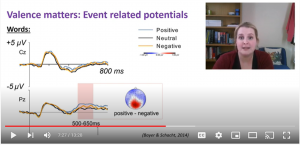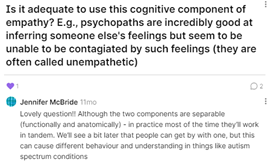Come watch with me: Blending the synchronous with the asynchronous to enhance learning and sense of belonging.
 Dr Jen McBride is a Senior Lecturer (teaching and
Dr Jen McBride is a Senior Lecturer (teaching and
scholarship) in Cognitive Neuroscience and Psychology in
the Faculty of Biology, Medicine and Health (FBMH).
Jen’s academic background is in cognition – specifically in
attention, mem ory, and behavioural control – and she has
a long-standing interest in using our understanding of
cognition to enhance our teaching. Jen is also particularly
interested in the social landscape in HE teaching, and how
this contributes to teaching, learning, and sense of
belonging in our students. Jen is now (since September
2022) the FBMH Associate-Dean for Teaching Excellence
and Student Outcomes, and is a Senior Fellow of the
Higher Education Academy (SFHEA)
When learning rapidly moved online during the Covid-19 pandemic, conversations with students made it clear that they really felt they were really missing the sense of community and the “University Experience” they had been expecting. Indeed there is general agreement that a sense of community is critical to students’ academic motivation and success, as well as their well-being (Osterman 2000; Cook-Sather, 2017; Bowskill et al., 2022; see also a recent report from Pearson/Wonkhe on building belonging). But this presents a key challenge in the move towards more online and blended learning in higher education: To create a flexible and inclusive learning experience that also encourages student engagement and student community and sense of belonging in a largely digital environment. One way to achieve this might be to enhance students’ sense of community and belonging to their cohort within the teaching sessions. Myself and others (e.g. Kuepper-Tetzel & Nordmann, 2021) delivered teaching via a watch-party format during the Covid-19 pandemic.
The central idea came from Watch Parties used by popular online streaming services: Promoting a shared experience in a digital environment fosters feelings of togetherness/community. Learners are physically separate, but come together at the same time online to view the same pre-prepared materials, and discuss them with one another and the lecturer in a live chatbox. When I tried this using Zoom during the pandemic it didn’t take long for the discussion to begin. Some students asked simple clarification questions – e.g. “what was CZ?” – so the chatbox meant students could have their misconception immediately corrected rather than this present an obstacle for the remainder of the session. Other students discussed really in-depth, critical-thinking, points related content that was not being covered in that particular class.
Students were extremely enthusiastic about watch-parties for teaching; formal and informal student-feedback was universally positive, and attendance remained high throughout the semester even though all materials were recorded and made available asynchronously.
The Chatbox is key – incorporating this in the move back to campus
After the success of my watch-party trial my natural inclination was to run controlled experiments to tease out what the causal factors were for the success of this approach (more details on this coming soon!). So far, all my data point to the chatbox as being the crucial element, and in controlled experiments that keep other factors (e.g. topic, lecturer) constant, a chatbox reliably improves both students’ learning and sense of community in both online and in-person formats.


Online Watch Parties for Teaching during the Pandemic
So clearly I want to keep the chatbox in my own teaching everywhere I can. The programmes I teach have large cohorts of students, and so in the return to more on-campus teaching post-pandemic we run these sessions in large lecture theatres with multiple screens – the lecture content is projected on one screen, with a Padlet chatbox accessed via a QR code on a mobile device projected onto another screen. This has worked well both with pre-recorded content (students come together in a lecture theatre to take part in the session) and live delivery (where we have two members of staff – one to deliver the live “lecture” material and the other to monitor the chatbox). Next year, I hope to be able to offer students a choice between attending the same session either online or in-person as best suits their own circumstances, especially as the cost-of-living crisis continues to bite.
Tips and Tricks
- If running an on-line watch party download the pre-recorded videos and run them from the desktop rather than try to live-stream them (it seemed to help preserve bandwidth)
- Set the social norms nice and early
- When online I ask for cameras off – I’ve found this to be most students’ preference anyway and this means camera-anxiety does not present an obstacle to engagement
- Encourage use of the chatbox — ask an easy question, or set up a quiz or poll, in the first few minutes of the session
- When the chat starts and questions come in that you’d like to respond to, remember that you have time to consider the response. You can look up links to relevant resources, and provide a really in-depth answer to support the student that they can return to asynchronously
- and providing really full answers also helps to reinforce the idea that students are welcome to use the chatbox
- They both worked well, but I preferred Padlet as a chatbox rather than Zoom’s built-in chat feature for the following reasons
- Students can “up-vote” or “like” a coursemate’s posts in Padlet
- Padlet allowed learners to “reply” to a coursemate’s question or thread – which made it easier to follow than a Zoom chatbox
- It was easy for students to be anonymous on padlet – they did not have to sign in with an account to use the padlet but they did in Zoom
- I can easily embed a Padlet in our virtual learning environment (Blackboard) so students can easily access this asynchronously after the session
Summary
Overall, watch-parties or adding a chatbox to a live lecture, fosters students’ sense of community and enhances learning. Students remain very enthusiastic about the approach, which marks a qualitative-shift in students’ attitudes towards online and blended learning in my programme so far.
References
Bowskill, N., Hall, D., Harrogate, M., & Hutchinson, L. (2022). Nostalgia, belonging and mattering: an institutional framework for digital collegiality drawn from teachers’ experience of online delivery during the 2020 pandemic. Journal of University Teaching & Learning Practice, 19(4), 17.
Cook-Sather, A. (2018). Listening to equity-seeking perspectives: How students’ experiences of pedagogical partnership can inform wider discussions of student success. Higher Education Research & Development, 37(5), 923-936.







0 Comments